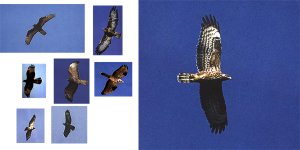Nick,
re your Staufen 'pair of adults':
pic 1 - I don't see anything Kite-like about it, are the wings pressed forward or drooping? A likely Honey but definite?
pic 2 - I assume is of the same bird shows what appears to be a distinct pale breast band which would put it 90%+ Common!
pics 3,4,5,6,7 and 8 - ie the other bird of the 'pair' - pale breast band, fine even barring on the tail, obvious occipital ridge? Not Honey but Common! No sign of any rudder movement of the tail in this 'sequence', which is primarily the thing that would give a honey buzzard it's 'Kite-like jizz'.
Pic 3, Hexham, 12th of May, 2002 shows a Common Buzzard - short tail and 'no neck'.
Perth bird probably good for Honey.
Passage bird pretty inconclusive. Maybe neither!
My gut instinct for some of the other birds tells me that some of them are good Honeys but ???
Familiarity with the more common species is vital when you are confronted with a potential Honey. This way it is easy to dismiss non-Honeys quickly - eg:
wing shape and attitude,
depth, frequency and flexibility of wingbeats,
tail-side shape and movement of the tail,
'centre of gravity' and shape of body.
Plumage details are often confusing, given the great variety in both species and the need for a fairly close view.
Honeys often don't 'do' anything. You can watch one for maybe 5-10 minutes, gliding towards, past and away from you, over perhaps 3 or more miles in distance, and if you are lucky it will be close and low enough to get the clincher! If at the closest, it's over a thousand feet up and a mile away you have almost no chance unless it puts in a deep, flexible wingbeat or starts wingclapping. Don't blink!
If you are not 100% on any 'confusion' species eg:
Common Buzzard,
Goshawk (head/neck and tail lengths similar),
Marsh and melanistic Montagu's Harriers (plumage),
Lesser Spotted Eagle (head-on or gliding away - drooping wings).
- it is not wise to publish.
Regards,
Andy.
P.S. no books were used to reference my replies, just my experience and discussions in the field with other enthusiasts and specialists, to whom I owe most of my UK experience with Honeys. They know who they are - thanks, lads! Hope I got it right








